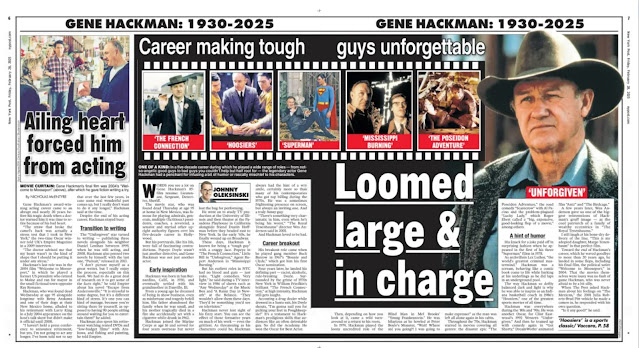Loomed large & in charge
Career making tough guys unforgettable
ONE OF A KIND: In a five-decade career during which he played a wide range of roles — from notso-angelic good guys to bad guys you couldn’t help but half root for — the legendary actor Gene Hackman had a penchant for infusing a bit of rascally mischief to his characters.
28 Feb 2025 - New York Post
JOHNNY OLEKSINSKI
WORDS you see a lot on Gene Hackman’s 85 film resume: Lieutenant, Sergeant, Detective, Sheriff. The movie star, who was found dead Wednesday at age 95 at home in New Mexico, was famous for playing admirals, generals, multiple (fictitious) presidents, coaches, a reverend, a senator and myriad other upright authority figures over his five-decade career in Hollywood.
But his portrayals, like his life, were full of fascinating contradictions. Popeye Doyle wasn’t just another detective, and Gene Hackman was not just another actor.
Early inspiration
Hackman was born in San Bernardino, Calif., in 1930, and eventually settled with his grandmother in Danville, Ill.
From a young age he dreamed of being in show business, even as misfortune and tragedy befell him. His father abandoned the family when he was small, and his mother tragically died in a fire she accidentally set with a cigarette while drunk in 1962.
Hackman joined the Marine Corps at age 16 and served for four years overseas but never lost the bug for performing.
He went on to study TV production at the University of Illinois and then theater at the Pasadena Playhouse in California alongside friend Dustin Hoffman before they headed east to New York. In the early ’60s, he finally wound up on Broadway.
These days, Hackman is known for being a “tough guy” with a craggy face. Popeye in “The French Connection,” Little Bill in “Unforgiven,” Agent Rupert Anderson in “Mississippi Burning.”
But his earliest roles in NYC had no blood and guts — just yuks. “Light comedies. Very light,” he said during a TV interview in 1986 of shows such as “Any Wednesday” at the Music Box and “A Rainy Day in Newark” at the Belasco. “They wouldn’t allow them these days. They’d be something you’d see on television.”
Hackman never lost sight of his fizzy start. You can see the effect of those formative years on much of his work — even the grittiest. As threatening as his characters could be, Hackman always had the hint of a wry smile, certainly more so than many of his contemporaries who got top billing during the 1970s. He was a sometimes frightening presence on screen, but always an inviting one. And a truly funny guy.
“There’s something very charismatic in him, even when he’s being his worst,” “The Royal Tenenbaums” director Wes Anderson said in 2001.
And Hackman loved to be bad.
Career breakout
His breakout role came when he played gang member Buck Barrow in 1967’s “Bonnie and Clyde,” which got him his first Oscar nomination.
Four years later, he landed his defining part — racist, alcoholic, rule-breaking Doyle. Surrounded by the grime of 1970s New York in William Friedkin’s brilliant “The French Connection,” at high intensity, Hackman still gets laughs.
Accosting a drug dealer while dressed in a Santa suit, his Doyle shouts, “I’m gonna nail you for picking your feet in Poughkeepsie!” It’s a testament to Hackman’s prodigious skills that audiences like an often detestable guy. So did the Academy. He won the Oscar for Best Actor.
Then, depending on how you look at it, came a wild turnaround or a return to his roots.
In 1974, Hackman played the loony uncredited role of the Blind Man in Mel Brooks’ “Young Frankenstein.” He was hilarious as he howled at Peter Boyle’s Monster, “Wait! Where are you going?! I was going to make espresso!” as the man was left all alone again in his cabin.
Throughout the ’70s, Hackman starred in movies covering all genres: the disaster epic “The Poseidon Adventure,” the road comedy “Scarecrow” with Al Pacino and the problem-plagued “Lucky Lady,” which Roger Ebert called a “big, expensive, good-looking flop of a movie,” among others.
A hint of humor
His knack for a joke paid off in surprising fashion when he appeared in the first of his three “Superman” films in 1978.
As archvillain Lex Luthor, “the world’s greatest criminal mastermind,” Hackman was a scream, behaving like a comic book come to life while barking at his underlings as he did laps in an underground pool.
The way Hackman so deftly balanced dark and light is why he was able to inspire as an Indiana basketball coach in 1986’s “Hoosiers,” one of the greatest sports movies of all time.
Hackman was everywhere during the ’80s and ’90s. He won another Oscar, for Clint Eastwood’s 1992 Western “Unforgiven.” And then he teamed up with comedy again in “Get Shorty,” DreamWorks’ animated film “Antz” and “The Birdcage.”
A few years later, Wes Anderson gave us one of the biggest reinventions of Hackman’s gruff image — as the cool patriarch of a family of wealthy eccentrics in “The Royal Tenenbaums.”
I still laugh at his bone-dry delivery of the line, “This is my adopted daughter, Margo Tenenbaum” in that perfect film.
Toward the end of Hackman’s career, which he waved goodbye to more than 20 years ago, he landed in some flops, including his final film, the political satire “Welcome to Mooseport,” in 2004. That the movies themselves were lousy was no fault of game Hackman, who was never afraid to be a bit silly.
When The Post asked Hackman about his feelings on “The Mexican,” the 2001 Julia Roberts-Brad Pitt vehicle he made a cameo in, he responded with his own question.
“Is it any good?” he said.



Commenti
Posta un commento